Oomycota: The organisms of Oomycota are not fungi in other words, they are Pseudofungi. They have been recognized as being notably different from the organisms included in the phylum Fungi for a long. As an illustration, in the classical concept, Oomycota species were allied with certain algae. However, because of a number of factors & tradition as well as practical considerations, there has been a tendency to classify Oomycota with true fungi.
Best safe and secure cloud storage with password protection
Get Envato Elements, Prime Video, Hotstar and Netflix For Free
Best Money Earning Website 100$ Day
#1 Top ranking article submission website
Class: Oomycetes
Oomycetes the class of inclusive, filamentous microorganisms that include some of the biggest threats to global food security with the most devastating plant pathogens.
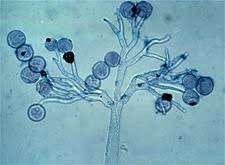
These are also known as “water molds”. The 500 or so species include both parasites and saprobes.
Habitat
- They occur predominantly in aquatic environments (both fresh and salt water) or moist soil but some are terrestrial.
- Most of the aquatic forms commonly refer as water molds.
- They are saprophytic and parasitic.
Somatic features
- They are both unicellular-holocarpic and eucarpic-filamentous species composed of profusely branched, coenocytic hyphae.
- Cell wall predominantly composed of β– 1, 3 & β–1, 6- glucans and cellulose rather than chitin.
Characteristics of Oomycetes
- Mostly aquatic, some are terrestrial.
- Vegetative thallus filamentous, coenocytic, in some groups unicellular (example –Olpidiopsis).
- Cell wall made up of glucans and cellulose lacking chitin (except for a few taxa).
- Asexual reproduction by means of biflagellate zoospores (larger forward directed tinsel and shorter backward directed whiplash type of flagella).
- Sexual reproduction is oogamous (by oogonia and antheridia) and produce oospores.
Oomycetes can reproduce both sexually and asexually.
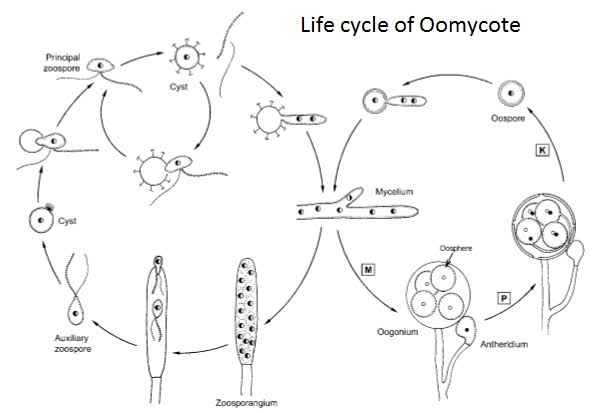
Asexual reproduction
- Asexual reproduction by means of heterokont biflagellate zoospores (heterokont refers to the characteristic form of cells, which typically have two unequal flagella) with a larger tinsel flagellum forward directed and a shorter whiplash flagellum directed backward.
- Zoospores produce within the sporangia that may vary from little more than swollen, lobed portion of hypha to spherical, oval or lemon shaped structures.
- Oomycetes produce two morphologically distinct biflagellate zoospores.
- Primary zoospores: Pear shaped (pyriform) with the flagella attached at the anterior end of the spore. These spores are poor swimmers and primitive one.
- Secondary zoospores: Kidney or bean shaped (reniform) structure with flagella inserted laterally in a groove on the spore surface.
Sexual reproduction
- Heterogametangic or oogamous (two heterogametangia come in contact and the contents of one flow into the other through a pore or tube) type of sexual reproduction.
- Gametangia typically differentiated into small hyphal-like male structures called antheridia and larger, globose female structures called oogonia.
- Antheridia and oogonia may produce same thallus or different thalli.
- Following meiosis one or more non-motile eggs or oospheres develop within each oogonium and haploid nuclei also produces within the antheridium.
- Hormones attract developing antheridia to oogonia and give rise to fertilization tube.
- A haploid nucleus of antheridium is introduced into the oosphere via the fertilization tube and fuses with the nucleus of the oosphere.
- Following fertilization an oosphere develops into an oospore that matures in the oogonium.
- Thick-wall, resistant structures capable of surviving unfavorable environmental conditions in oospores.
- Upon germination an oospore gives rise to a diploid thallus.
Class Oomycetes is divided into five orders & three families. These are:
- Saprolegniales (Saprolegnia)
- Lagenidiales (Lagenidium)
- Leptomitales (Leptomitus)
- Rhipidiales (Rhipidium)
- Peronosporales
Family 1: Pythiaceae (Pythium; Phytophthora infestans– Late blight of potato).
Family 2: Peronosporaceae (Plasmopara viticola– Downy mildew of grape).
Family 3: Albuginaceae (Albugo candida– White rust fungus).
References & Other Links
This Article is completely based on by the lecture of Sorwar Hossain, Lecturer, Department of Botany, University of Dhaka.
Author has added Some info and pictures.
- Introduction To Mycology by Alexopoulos.
 Plantlet The Blogging Platform of Department of Botany, University of Dhaka
Plantlet The Blogging Platform of Department of Botany, University of Dhaka
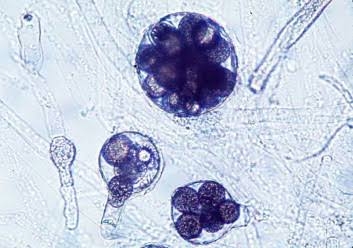


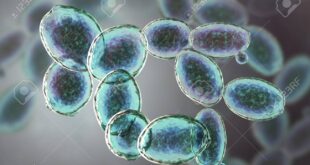
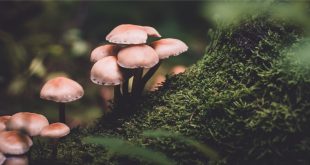
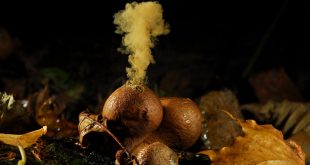
So much impressive yo.